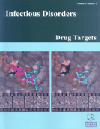- Home
- A-Z Publications
- Infectious Disorders - Drug Targets (Formerly Current Drug Targets - Infectious Disorders)
- Previous Issues
- Volume 12, Issue 2, 2012
Infectious Disorders - Drug Targets (Formerly Current Drug Targets - Infectious Disorders) - Volume 12, Issue 2, 2012
Volume 12, Issue 2, 2012
-
-
Some Personal Memories of Bob Chanock
More LessBy John MillsThis issue of Infectious Disorders - Drug Targets, with a series of important papers on respiratory syncytial virus, is dedicated to Dr. Robert Chanock. For about a half century, Robert Merritt Chanock (known universally as “Bob Chanock”, or occasionally as just “Chanock”), was a dominant figure in international virology, and arguably the dominant figure in the world of respiratory virology. Chanock’s many scientific achievements ha Read More
-
-
-
Editorial [Hot Topic: RSV Research is Now Close to Providing Solutions to RSV Infection (Guest Editors: Reena Ghildyal and John Mills)]
More LessAuthors: Reena Ghildyal and John MillsThe discovery of respiratory syncytial virus and the connection between RSV infection and severe respiratory disease in children was made over a half-century ago by Bob Chanock and his colleagues. In the intervening decades it has become clear that RSV is a major respiratory pathogen – nearly equal or second only to influenza virus – of infants, children, adults, the elderly and immunosuppressed individuals of all ages. If t Read More
-
-
-
The Burgeoning Burden of Respiratory Syncytial Virus Among Children
More LessRespiratory syncytial virus (RSV) was first isolated from infants by Chanock and colleagues in 1957. However, control of this ubiquitous agent has yet to be achieved. RSV is recognized as the primary cause of hospitalization for acute lower respiratory tract illness (LRTI) among infants worldwide. Among children <5 years old, annual hospitalization rates in the United States (US) is 3/1000 children, and rates in Canada a Read More
-
-
-
Respiratory Syncytial Virus Infection in Adult Populations
More LessAuthors: Edward E. Walsh and Ann R. FalseyRespiratory Syncytial Virus, generally recognized for its role as the major respiratory pathogen in newborn infants and young children, is also a significant pathogen in adults. It is a frequent cause of upper and lower respiratory illness among all age groups, although it often goes unrecognized in adults unless highly sensitive molecular diagnostic tests are used. All RSV infections in adults represent re-infection and Read More
-
-
-
Protein-Protein Interactions in RSV Assembly: Potential Targets for Attenuating RSV Strains
More LessAuthors: Reena Ghildyal, David A. Jans, Philip G. Bardin and John MillsRespiratory syncytial virus (RSV) is the major respiratory pathogen of infants and children worldwide, with no effective treatment or vaccine available. Steady progress has been made in understanding the respiratory syncytial virus lifecycle and the consequences of infection, but some areas of RSV still remain poorly understood. Although many of the interactions between virus proteins that are required for efficient RSV Read More
-
-
-
Targeting RSV with Vaccines and Small Molecule Drugs
More LessRespiratory syncytial virus (RSV) is the most significant cause of pediatric respiratory infections. Palivizumab (Synagis®), a humanized monoclonal antibody, has been used successfully for a number of years to prevent severe RSV disease in at-risk infants. However, despite intense efforts, there is no approved vaccine or small molecule drug for RSV. As an enveloped virus, RSV must fuse its envelope with the host cell membrane, Read More
-
-
-
The Non-Structural Proteins of RSV: Targeting Interferon Antagonists for Vaccine Development
More LessOver fifty years have passed since the identification of respiratory syncytial virus (RSV) as an important pediatric pathogen. However, an effective vaccine is still lacking. Immunization with formalin-inactivated RSV resulted in vaccine-enhanced disease; thus, a greater focus has been placed more recently on developing live attenuated RSV vaccines. The difficulty in identifying a live attenuated vaccine candidate has been bala Read More
-
-
-
Necrotizing Acute Pancreatitis Current Status - Emerging New Strategies in Surgical Management
More LessDespite that pancreatic necrosis complicates only 15 % of cases of acute pancreatitis (AP), it is associated with high morbidity and considerable mortality. In an attempt to improve prognosis, many surgical strategies have been described during the last few decades. Currently, necrosectomy remains the cornerstone in the surgical treatment of infected pancreatic necrosis and in selected cases of sterile necrotizing pancreatiti Read More
-
-
-
Prion Disease: Chemotherapeutic Strategies
More LessPrion diseases, also known as transmissible spongiform encephalopathies, are invariably fatal neurodegenerative diseases for which there are no efficacious treatments. Thousands of compounds have been screened for anti-prion effect, and yet of those that have effect in vitro, very few show effect in vivo, especially if administered in the later stages of disease. However, with new techniques for early diagnosis being developed Read More
-
-
-
Mitochondrial Dysfunction and Antioxidant Therapy in Sepsis
More LessAuthors: Milagros Rocha, R. Herance, S. Rovira, Antonio Hernandez-Mijares and Victor M. VictorSepsis and septic shock are the major causes of death in intensive care units. Oxidative damage to mitochondria is involved in the development of organ dysfunction associated with sepsis. This syndrome is caused by an excessive defensive and inflammatory response characterised by a massive increases of reactive oxygen species (ROS), nitric oxide (NO) and inflammatory cytokines. Under normal circumstances, compl Read More
-
Volumes & issues
-
Volume 25 (2025)
-
Volume 24 (2024)
-
Volume 23 (2023)
-
Volume 22 (2022)
-
Volume 21 (2021)
-
Volume 20 (2020)
-
Volume 19 (2019)
-
Volume 18 (2018)
-
Volume 17 (2017)
-
Volume 16 (2016)
-
Volume 15 (2015)
-
Volume 14 (2014)
-
Volume 13 (2013)
-
Volume 12 (2012)
-
Volume 11 (2011)
-
Volume 10 (2010)
-
Volume 9 (2009)
-
Volume 8 (2008)
-
Volume 7 (2007)
-
Volume 6 (2006)
Most Read This Month
Article
content/journals/iddt
Journal
10
5
false
en


